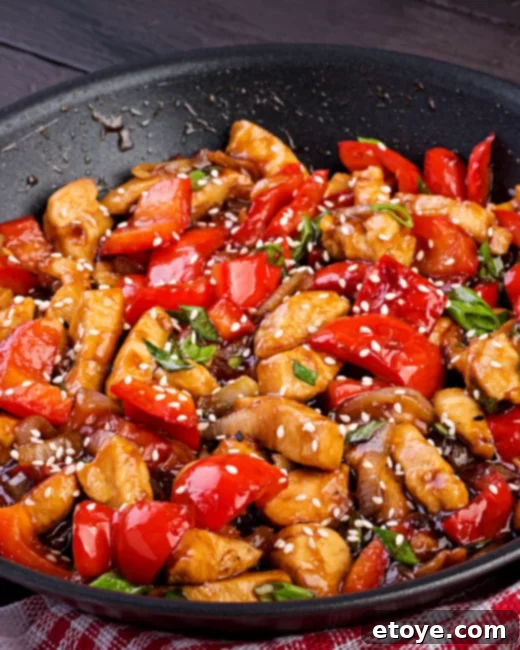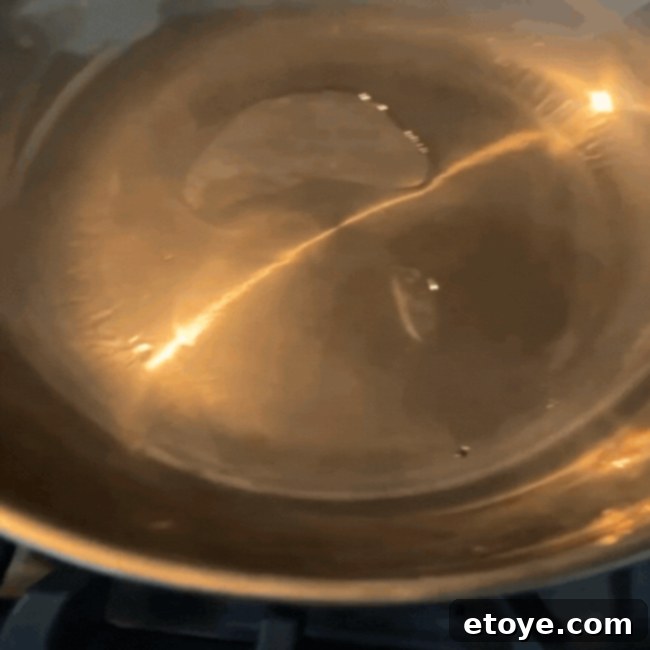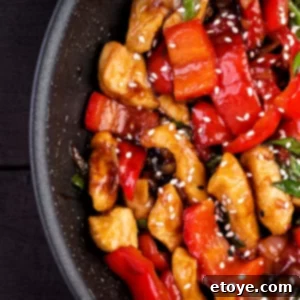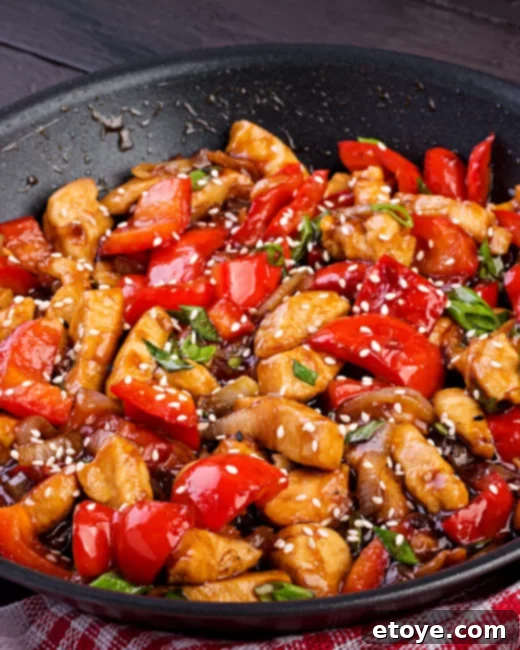If you’re seeking a delicious meal that comes together in mere minutes, you’ve landed in the right spot. My culinary journey, much like many busy home cooks, evolved significantly over time. I once considered myself a food purist, scoffing at the thought of anything store-bought, always insisting on creating every sauce and component from scratch. This all changed with the beautiful chaos of parenthood. Time became a precious commodity, forcing a complete overhaul of my cooking philosophy.
These days, my kitchen focus is still on fresh, high-quality ingredients and mastering proper cooking techniques. However, I’ve also become adept at leveraging smart shortcuts, particularly with versatile store-bought sauces. This approach not only slashes cooking time but can surprisingly trim your grocery bill too. The goal is to maximize flavor and minimize effort, ensuring that even on the busiest weeknights, a wholesome, homemade meal is always within reach.
Before we dive into crafting this incredibly flavorful Teriyaki Chicken Stir-Fry, let’s unlock some fundamental kitchen wisdom that will revolutionize your stir-frying experience. I’m eager to share the secrets that will elevate your quick meals from good to absolutely outstanding:
- Discover why a common “stir-fry” approach for chicken often leads to lackluster results, and why a simple “leave it alone” technique is the key to perfectly seared, juicy poultry.
- Learn the critical timing of adding aromatics like garlic and ginger, ensuring their vibrant flavors infuse your dish without the dreaded burnt, bitter taste.
- Understand why heartier vegetables, such as broccoli, require a special pre-treatment to achieve that coveted crisp-tender texture in your stir-fry.

The Magic Behind The Method: Why This Teriyaki Stir-Fry Shines
This isn’t just another stir-fry recipe; it’s a masterclass in efficiency and flavor development, designed for the modern home cook. Each technique is purposefully chosen to deliver maximum impact with minimal fuss, ensuring a restaurant-quality meal right in your own kitchen.
- Perfectly Seared Chicken: The secret to truly delicious stir-fried chicken lies in giving it space and time. Instead of constantly stirring, allowing the chicken pieces to sear undisturbed develops a beautiful golden-brown crust. This Maillard reaction not only locks in natural juices but also creates complex, savory flavors that a quickly tossed chicken can never achieve. It transforms bland poultry into tender, irresistible bites that truly elevate the entire dish.
- Layering Flavors Strategically: Aromatics like garlic and ginger are the soul of many Asian-inspired dishes. However, they are delicate and burn quickly at high temperatures. Introducing them midway through the cooking process ensures they release their fragrant oils and infuse the dish without turning bitter or acrid. This strategic timing preserves their bright, pungent notes, making every mouthful a burst of aromatic bliss and adding depth that would otherwise be lost.
- Harmony of Textures in Every Bite: A great stir-fry offers a delightful contrast of textures. Achieving this means being mindful of when and how different vegetables are added to the pan. Tougher vegetables like broccoli or carrots require a bit more cooking time than delicate greens or bell peppers. By pre-treating or adding them at the correct moment, we ensure every vegetable reaches its ideal crisp-tender state, complementing the tender chicken beautifully and creating a varied, enjoyable eating experience.
Mastering Stir-Fry Basics for Home Cooks
While stir-frying might seem straightforward, mastering a few core principles can drastically improve your results, especially when cooking on standard home stovetops that lack the intense heat of professional kitchens.
Do I need a wok for an authentic stir-fry?
While a wok is undoubtedly the quintessential stir-fry tool, it’s not strictly mandatory for success. Its high, sloped sides and rounded bottom are designed for even heat distribution and easy tossing, making stir-frying a breeze. But a wok’s utility extends far beyond just stir-frying; it’s a remarkably versatile piece of cookware that I use for steaming, boiling, braising, and even deep-frying. In fact, roughly 80% of my cooking happens in my wok!
If you don’t own a wok, a 12-inch sauté pan or a high-sided frying pan makes an excellent substitute. The key is its high sides, which prevent ingredients from spilling out when you vigorously toss and stir. Ensure it’s a heavy-bottomed pan that can retain heat well, which is crucial for achieving good browning.
What’s the secret behind not “stir-frying” chicken immediately?
Many traditional stir-fry recipes originate from restaurant kitchens or homes in Asia equipped with powerful gas or propane stoves, capable of generating incredibly high heat for wok cooking. Home kitchen stoves, even gas ones, typically produce significantly less heat, and electric stovetops are even milder. This difference in heat output necessitates a change in technique.
Achieving delicious, juicy, and perfectly browned chicken requires sufficient high heat to initiate the Maillard reaction – the chemical process responsible for that flavorful golden crust. If you constantly move the chicken pieces around – tossing, flipping, stirring – the pan temperature drops, and the chicken struggles to brown. Instead, arrange your chicken pieces in a single layer on the hot cooking surface and resist the urge to move them. Allow them adequate time and space to develop that rich, savory browning on one side, then flip them to achieve the same on the other. This patience is rewarded with chicken that’s tender on the inside and beautifully caramelized on the outside.
Why delay adding ginger and garlic to your stir-fry?
Many recipes instruct you to cook aromatics like minced ginger and garlic at the very beginning. While this works for professional chefs with high-powered woks and lightning-fast hands, for home cooks using standard stovetops, this often leads to burnt, bitter aromatics within seconds. These delicate ingredients can go from fragrant to charred incredibly quickly at high heat.
To demonstrate, heat your wok or sauté pan over high heat, swirl in some cooking oil, then add minced ginger and garlic. Stir-fry for just a few seconds until fragrant. You’ll notice how quickly they begin to brown. Any longer, and they’ll turn crispy and bitter, tainting your entire dish. That’s why my method calls for adding ginger and garlic *after* the chicken has had a chance to brown. This ensures their vibrant flavor is preserved and beautifully integrated into the stir-fry.

Can I cook ginger and garlic on lower heat to prevent burning?
You certainly could cook aromatics on lower heat, but remember our primary goal: perfectly browned chicken. The chicken absolutely requires high heat to develop that desirable crust and flavor. If you cook the ginger and garlic on low heat until they’re done, and then crank up the heat for the chicken, those delicate aromatics will still end up overcooked and bitter by the time the chicken finishes browning. The best approach is to maintain high heat for the chicken, then introduce the ginger and garlic at the opportune moment, ensuring both components are cooked to perfection without compromise. Again, add the ginger and garlic *after* browning the chicken.
Can I incorporate hearty vegetables like broccoli into this stir-fry?
Absolutely! Adding robust vegetables such as broccoli, carrots, cauliflower, or green beans is a fantastic way to boost nutrition and texture. However, these denser vegetables require longer cooking times than thinner, quicker-cooking counterparts like bell peppers or snap peas. Adding them directly into the stir-fry at the same time as other vegetables can throw off your timing, resulting in either undercooked tough veggies or overcooked mushy ones.
The solution is a simple extra step: par-boiling. Fill your wok or pan with water and bring it to a rolling boil. Add your broccoli florets (or other tough vegetables) and cook for about 2 minutes. They should turn bright green and still be very crunchy, not fully cooked through. Drain them immediately and set them aside. Now, your broccoli is partially cooked, ensuring it will finish cooking alongside the other, quicker-cooking vegetables in the stir-fry, all while maintaining its delightful crisp-tender bite.
The Teriyaki Twist: Reverse Meal Plan in Action
We’ve all been there – staring into a fridge full of leftovers and random ingredients, wondering how to conjure a fresh, exciting meal. This is precisely where the magic of Reverse Meal Planning shines. This Teriyaki Chicken Stir-Fry isn’t just a stellar dish on its own; it’s a master at transforming existing ingredients into something new and delicious, minimizing food waste and maximizing creativity.
- Have some leftover rice or noodles? Perfect. Use this vibrant stir-fry as a flavorful topping, and you’ve instantly created a complete, satisfying meal in minutes. The savory-sweet teriyaki sauce pairs wonderfully with plain grains or pasta, bringing new life to yesterday’s carbs.
- Discovered a random assortment of vegetables? Zucchini, mushrooms, baby corn, bok choy, or even spinach? Don’t let them go to waste! Toss them into the stir-fry. The adaptable teriyaki sauce embraces all with its rich, savory-sweet hug. Just remember to adjust the cooking time based on the vegetable’s toughness and consider par-boiling those that need a head start.
- Stumbled upon yesterday’s grilled chicken, steak, or even tofu slices? This is where it gets truly exciting. Thinly slice your cooked protein, throw it into the stir-fry towards the end of the cooking process, and watch as it soaks up that rich teriyaki goodness. It will taste even better than it did the day before, making for an effortless and flavorful protein boost.
Remember, the heart of Reverse Meal Planning is adaptability and innovation. It’s the joy of discovery, the thrill of crafting something fresh and appealing from what you already have on hand, turning potential waste into culinary triumph.
Teriyaki Tidbits: Your Stir-Fry Questions Answered
We’ve covered the core techniques, but you might have a few more questions buzzing around your kitchen. Here are answers to common queries about making the perfect Teriyaki Stir-Fry:
- Can I use a different protein for this recipe? Absolutely! While chicken is our star today, this recipe is incredibly versatile. Feel free to swap it out for thinly sliced beef strips, firm tofu cubes, succulent shrimp, or even pork. Just remember to adjust the cooking times accordingly. Shrimp, for example, cooks much faster than chicken, while beef might require a slightly different searing approach depending on the cut.
- I’m out of snap peas! Can I substitute with another vegetable? Definitely. Think of this recipe as a delightful dance with flexibility. Broccoli florets (par-boiled if large), green beans, snow peas, sliced carrots, or even thinly sliced zucchini would be wonderful stand-ins. The goal is to use what you have and what you enjoy. Just keep in mind that some vegetables might require a slightly longer or shorter cook time to reach that ideal crisp-tender texture.
- What’s the secret behind the perfect teriyaki sauce? Balance, my friend, is key. The perfect interplay of sweet, salty, and umami flavors makes teriyaki sauce so irresistible. While a quality store-bought sauce offers convenience, if you’re feeling adventurous, you can craft your own at home using a base of soy sauce, mirin (sweet rice wine), sake, and a touch of sugar or honey, often thickened slightly with cornstarch. Experiment to find your perfect sweet-savory ratio!
- My sauce isn’t thickening as expected. What can I do? This is a common and easily fixable issue. A quick fix is to create a cornstarch slurry. In a small bowl, mix one teaspoon of cornstarch with two teaspoons of cold water until smooth. Once your stir-fry is almost complete, add this slurry to the pan while stirring constantly. Give it a minute or two over heat, and it will work its thickening magic, transforming your sauce into a glossy, clingy glaze.
- Can I make this dish ahead of time and reheat it later? Yes, you can, but with a little strategic planning to ensure the best results. If preparing ahead, slightly undercook your vegetables so they retain some crispness. When you reheat, they’ll finish cooking without turning mushy. Store the stir-fry in an airtight container in the refrigerator and enjoy it within 2-3 days for optimal flavor and texture. Reheat gently in a pan or microwave.
- What kind of oil is best for stir-frying? For stir-frying, you need an oil with a high smoke point that can withstand the intense heat without burning. Good options include peanut oil, canola oil, grapeseed oil, or vegetable oil. Olive oil, particularly extra virgin, has a lower smoke point and isn’t ideal for high-heat cooking like stir-frying.
More Tantalizing Teriyaki Twists from Steamy Kitchen
If you’ve fallen in love with the vibrant flavors of teriyaki, explore these other fantastic recipes from Steamy Kitchen:
- Shrimp Teriyaki Stir-Fry Recipe
- Pineapple Chicken Teriyaki Buddha Bowl Recipe
- Salmon Teriyaki Recipe with Video
- Teriyaki Mushroom Sauce with Grilled Salmon

Stir-Fry Teriyaki Chicken Recipe: Quick & Flavorful
Pin Recipe
Ingredients
For Stir-Fry Teriyaki Chicken
- 1 pound (approx. 450g) boneless, skinless chicken breasts sliced into thin strips
- 2 tablespoons soy sauce
- 2 tablespoons store-bought teriyaki sauce
- 1 tablespoon honey
- 1 tablespoon rice vinegar
- 1 teaspoon cornstarch
- 1 tablespoon cooking oil (e.g., peanut, canola, or vegetable oil)
- 2 cloves garlic minced
- 1- inch piece of fresh ginger grated
- 1 cup broccoli florets (par-boiled if desired, see notes)
- 1 bell pepper (any color), thinly sliced
- 1 carrot thinly sliced or julienned
- 1/2 cup snap peas
- 2 green onions sliced, for garnish
- Sesame seeds for garnish
Instructions
- In a small bowl, whisk together the soy sauce, store-bought teriyaki sauce, honey, rice vinegar, and cornstarch until the mixture is smooth and well combined. Set this flavorful sauce aside.
- Heat the cooking oil in a large skillet or wok over medium-high heat until shimmering. Add the chicken strips, spreading them in a single layer. Allow them to sear undisturbed for 2-3 minutes until beautifully browned on one side, then flip and brown the other side for another 2-3 minutes, until cooked through.
- Once the chicken is browned, add the minced garlic and grated ginger to the skillet. Stir-fry quickly for just 30-60 seconds until fragrant, being careful not to burn them.
- Introduce the prepared vegetables: broccoli florets (par-boiled if using), thinly sliced bell pepper, julienned carrot, and snap peas. Continue to stir-fry for an additional 3-4 minutes, or until the vegetables reach a crisp-tender consistency.
- Give your reserved teriyaki sauce mixture a quick whisk again, then pour it evenly over the chicken and vegetables in the skillet. Stir everything thoroughly to ensure all ingredients are well coated. Cook for another 1-2 minutes, stirring gently, allowing the sauce to thicken to a glossy glaze.
- Remove the skillet from the heat. Garnish generously with freshly sliced green onions and a sprinkle of sesame seeds for added flavor and visual appeal.
- Serve your delectable Teriyaki Chicken Stir-Fry immediately over a bed of warm steamed rice, noodles, or quinoa for a complete and satisfying meal. Enjoy!
Notes
Nutrition
